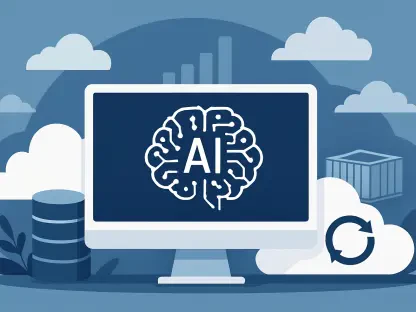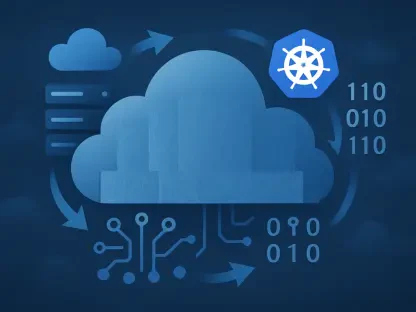As organizations rely more heavily on cloud computing to strengthen and streamline their operations, it becomes clear that traditional monitoring methods are no longer adequate to handle the increasing complexity of these environments. Traditional techniques often result in downtime and inefficiency, revealing an urgent need for more advanced approaches. AI-driven monitoring solutions are at the forefront of this transformation, offering proactive, efficient, and secure alternatives to manage cloud infrastructure. This article explores how AI is revolutionizing cloud operations through resource optimization, enhanced security, and reduced downtime, while also addressing the potential challenges organizations may encounter.
The Shift from Traditional to AI-Driven Monitoring
Limitations of Traditional Monitoring
Organizations have long relied on traditional monitoring techniques, which involve fixed thresholds and manual interventions. These dated methods tend to be reactive, addressing issues only after they have already caused disruptions. As a consequence, this reactive nature often leads to delayed responses and inefficient resource utilization. With the increasing demands on cloud systems, the inflexibility and slow reaction times of traditional monitoring can result in significant operational inefficiencies and increased costs.
The manual interventions required by traditional methods further expose cloud infrastructure to human error. Such errors can lead to prolonged downtimes, exacerbating the impact on business operations. Moreover, setting and maintaining fixed thresholds in dynamic cloud environments is increasingly impractical. Fixed thresholds do not adapt to changing workloads or evolving security threats, leaving systems vulnerable and organizations unable to respond promptly. This situation underscores the limitations of traditional monitoring and the imperative need for more advanced techniques.
Emergence of AI-Driven Monitoring
AI-driven monitoring represents an evolution in cloud infrastructure management, fundamentally shifting from reactive to proactive methods. Leveraging machine learning (ML) algorithms, AI-driven monitoring can detect anomalies and predict potential failures before they disrupt systems. This shift allows for real-time corrective actions that minimize downtime and optimize resource use. By automating routine monitoring tasks, AI frees IT teams to focus on strategic initiatives, thereby enhancing overall operational efficiency and innovation.
Another transformative aspect of AI-driven monitoring is its capacity for continuous learning and adaptation. Unlike traditional systems with static thresholds, AI models can adapt to historical data trends and evolving conditions within the cloud environment. This adaptability results in more accurate and timely responses to emerging issues, significantly reducing the risk of disruptions. As a result, AI-driven monitoring not only enhances the reliability of cloud operations but also contributes to a more resilient infrastructure capable of meeting the demands of modern business environments.
Enhancing Data Processing and Visibility
Advanced Data Collection Capabilities
AI-powered tools enhance the ability to collect and process vast datasets originating from various components of the cloud environment. These components include application logs, system metrics, and network traffic, collectively providing comprehensive data necessary for accurate monitoring. AI-driven systems can aggregate and process millions of data points per second, far surpassing the capabilities of traditional methods. Such capacity for extensive data collection and speedy processing allows for quicker and more informed decision-making.
The integration of these vast data sets helps to create a holistic view of the cloud infrastructure, identifying patterns and correlations that might otherwise go unnoticed. Advanced data collection capabilities enable organizations to foresee potential bottlenecks and allocate resources effectively. As these AI-driven tools continuously enhance their data repositories, they refine their ability to make insightful predictions and recommendations, further optimizing the performance and reliability of cloud systems.
Comprehensive Visibility for Performance Management
One of the crucial advantages of AI-driven monitoring is its ability to provide comprehensive visibility into cloud performance. By analyzing interactions among server loads, network latencies, and user access patterns, AI systems can detect hidden issues that might impact overall performance. This holistic approach to monitoring ensures that performance management strategies are not only reactive but also proactive, allowing for preemptive measures to be taken before minor issues escalate into significant problems.
With comprehensive visibility, organizations can better understand how different components of their cloud infrastructure interact. This insight is invaluable for optimizing performance, as it helps identify the root causes of inefficiencies and guides the implementation of targeted improvements. Enhanced visibility also leads to more accurate capacity planning and better resource allocation, ensuring that the infrastructure remains resilient and capable of handling varying workloads effectively.
Strengthening Cloud Security with AI
Advanced Anomaly Detection Techniques
Securing cloud environments requires sophisticated methods to identify and mitigate potential threats. AI-driven monitoring leverages advanced anomaly detection techniques through supervised and unsupervised learning methods. These AI-based systems can identify unusual patterns in system behavior by continuously analyzing vast amounts of data and adapting to historical trends. Unlike static, threshold-based security systems, AI algorithms dynamically adapt to new information, reducing false positive rates and improving the accuracy of threat detection.
The ability of AI-driven systems to learn and adapt is particularly beneficial in identifying sophisticated threats that static systems might overlook. As cyber threats evolve, the adaptability of AI-based security monitoring ensures that organizations are equipped to detect and respond to new attack vectors quickly. This continuous learning and dynamic adaptation make AI-driven anomaly detection a powerful tool in enhancing the overall security posture of cloud infrastructure.
Effective Threat Detection
The adaptability and continuous monitoring capabilities of AI-driven systems significantly bolster their effectiveness in threat detection. By regularly updating their models based on newly encountered data, these systems can identify emerging cyber threats more effectively than traditional methods. This proactive stance helps in preempting potential breaches and mitigating their impact, reducing the likelihood of service interruptions and data loss. The real-time nature of AI-driven security monitoring ensures that threats are addressed promptly, strengthening the overall security framework of cloud environments.
Furthermore, AI-driven monitoring systems can integrate threat intelligence from various sources, combining industry insights with their own historical data to enhance their detection capabilities. This comprehensive approach ensures that the systems remain up-to-date with the latest threat landscapes, providing robust protection against a wide range of cyber threats. As security threats become increasingly complex, the advanced capabilities of AI-driven systems will become indispensable in maintaining the integrity and availability of cloud services.
Predictive Scaling for Optimal Resource Utilization
Overcoming Traditional Scaling Limitations
Traditional scaling methods in cloud environments typically react to fluctuations in demand only after they occur, leading to inefficiencies and suboptimal resource utilization. These reactive approaches often result in periods of under-provisioning or over-provisioning, negatively impacting performance and operational costs. AI-driven predictive scaling offers a solution to these challenges by analyzing historical data to anticipate future resource requirements, enabling timely and precise resource allocation.
Predictive scaling models utilize machine learning algorithms to analyze patterns and trends within historical usage data, forecasting demand and automatically adjusting resource allocation accordingly. This proactive approach ensures that resources are provisioned in anticipation of demand spikes, significantly improving performance and user experience. By alleviating the inefficiencies associated with traditional scaling methods, predictive scaling helps organizations optimize their cloud infrastructure and reduce operational costs.
Benefits of Predictive Capabilities
The advantages of AI-driven predictive scaling extend beyond improved performance and cost efficiency. By preemptively allocating resources based on anticipated demand, organizations can ensure that their cloud infrastructure remains responsive and reliable. This proactive approach reduces the risk of performance bottlenecks during peak usage periods, thereby enhancing the overall user experience. Predictive scaling also helps organizations manage cloud billing more effectively, as resources are allocated based on actual needs rather than conservative estimates.
Additionally, the predictive capabilities of AI-driven monitoring systems facilitate better capacity planning and resource management. Organizations can use these insights to optimize their infrastructure, ensuring that resources are available when needed without unnecessary expenditure. The ability to accurately forecast demand and adjust resource allocation accordingly is invaluable in maintaining a cost-effective and efficient cloud environment. By leveraging AI-driven predictive scaling, organizations can achieve a balance between performance and cost, optimizing their cloud infrastructure for both current and future needs.
Automated Remediation and Operational Efficiencies
Reducing Human Intervention
AI-driven monitoring systems not only detect and predict issues, but they can also autonomously remediate them, significantly reducing the need for human intervention. This capability is particularly valuable in large-scale cloud environments where manual remediation would be time-consuming and prone to errors. AI systems can automatically restart services, reallocate resources, and adjust configurations to maintain system stability, ensuring that issues are addressed promptly and efficiently.
The automation of remediation tasks helps to minimize downtime and maintain continuous operations, enhancing the overall resilience of the cloud infrastructure. By offloading routine and repetitive tasks to AI-driven systems, IT teams can focus their attention on more strategic initiatives that drive innovation and business growth. This shift in focus not only improves operational efficiency but also fosters a culture of continuous improvement and innovation within the organization.
Focusing on Innovation
The ability to automate remediation and reduce human intervention has significant implications for the allocation of IT resources and strategic planning. As AI-driven monitoring systems handle routine tasks, IT teams are freed to concentrate on higher-value projects and initiatives. This shift in focus enables organizations to leverage their IT expertise more effectively, driving innovation and competitive advantage. Continuous learning from incidents captured by AI systems further enhances the resilience and reliability of cloud infrastructure.
By providing IT teams with the flexibility to focus on innovation and strategic planning, AI-driven monitoring systems contribute to the overall growth and success of the organization. The insights generated by these systems can inform decision-making and guide the development of new products and services, positioning the organization to capitalize on emerging opportunities. As AI-driven monitoring becomes more integrated into cloud management practices, its role in enhancing both operational efficiency and strategic initiatives will become increasingly prominent.
Financial and Operational Benefits
Cost-Effective Cloud Management
The financial and operational benefits of AI-driven monitoring are substantial, directly impacting an organization’s bottom line. By optimizing resource allocation and reducing cloud waste, these systems help lower operating costs and enhance overall efficiency. The automation of routine monitoring and remediation tasks minimizes unplanned downtimes, which can be costly in terms of both revenue loss and reputational damage. These efficiencies translate into significant cost savings for organizations, making AI-driven monitoring a valuable investment.
Improved cloud management also results in better utilization of existing resources, reducing the need for additional infrastructure investments. By accurately predicting demand and optimizing resource allocation, organizations can maximize the efficiency of their cloud environments, ensuring that they get the most value from their investments. The cost savings associated with AI-driven monitoring extend to reduced administrative overhead, as the automation of compliance reporting and other routine tasks frees up valuable IT resources.
Enhanced Security and Compliance
Enhanced security is another critical benefit of AI-driven monitoring. By reducing the likelihood of data breaches and other security incidents, these systems help mitigate financial risks associated with cyber threats. The ability to continuously monitor and adapt to evolving threat landscapes ensures that organizations remain protected against a wide range of security challenges. This enhanced security posture not only reduces the risk of financial losses but also helps organizations maintain the trust and confidence of their customers.
In addition to bolstering security, AI-driven monitoring systems facilitate compliance with regulatory requirements by automating compliance reporting and documentation. This automation reduces the administrative burden on IT teams and minimizes the risk of non-compliance penalties. By ensuring that security and compliance requirements are met, AI-driven monitoring contributes to a more secure and resilient cloud environment, aligning with organizational goals and regulatory standards.
Addressing Implementation Challenges
Ensuring Data Quality and Integration
Although the advantages of AI-driven monitoring are evident, its implementation poses certain challenges that organizations must address. Ensuring high-quality, up-to-date data is vital for accurate predictions and effective monitoring. Organizations need to establish robust data governance practices to maintain data integrity and reliability. Additionally, seamless integration of AI applications within existing cloud infrastructures requires adopting common frameworks and establishing interoperability between different systems.
Data integration is particularly crucial in heterogeneous environments where multiple cloud services and on-premises systems coexist. Ensuring that data flows seamlessly across these disparate systems is essential for the accuracy and effectiveness of AI-driven monitoring. Organizations must also invest in the necessary infrastructure and tools to support the integration of AI applications, ensuring that they can harness the full potential of these advanced monitoring solutions.
Building Confidence in AI Systems
As organizations increasingly depend on cloud computing to enhance and streamline their operations, it is evident that traditional monitoring methods are insufficient to manage the growing complexity of these environments. These outdated techniques frequently result in downtime and inefficiencies, highlighting a critical need for more sophisticated solutions. AI-driven monitoring tools are leading this shift, presenting proactive, efficient, and secure means to handle cloud infrastructure. This article delves into the transformative impact of AI on cloud operations, focusing on optimal resource utilization, improved security, and minimized downtime. It also addresses the potential challenges that organizations may face during this transition. With AI at the helm, companies can expect more reliable and robust cloud management, paving the way for a more resilient operational ecosystem.









